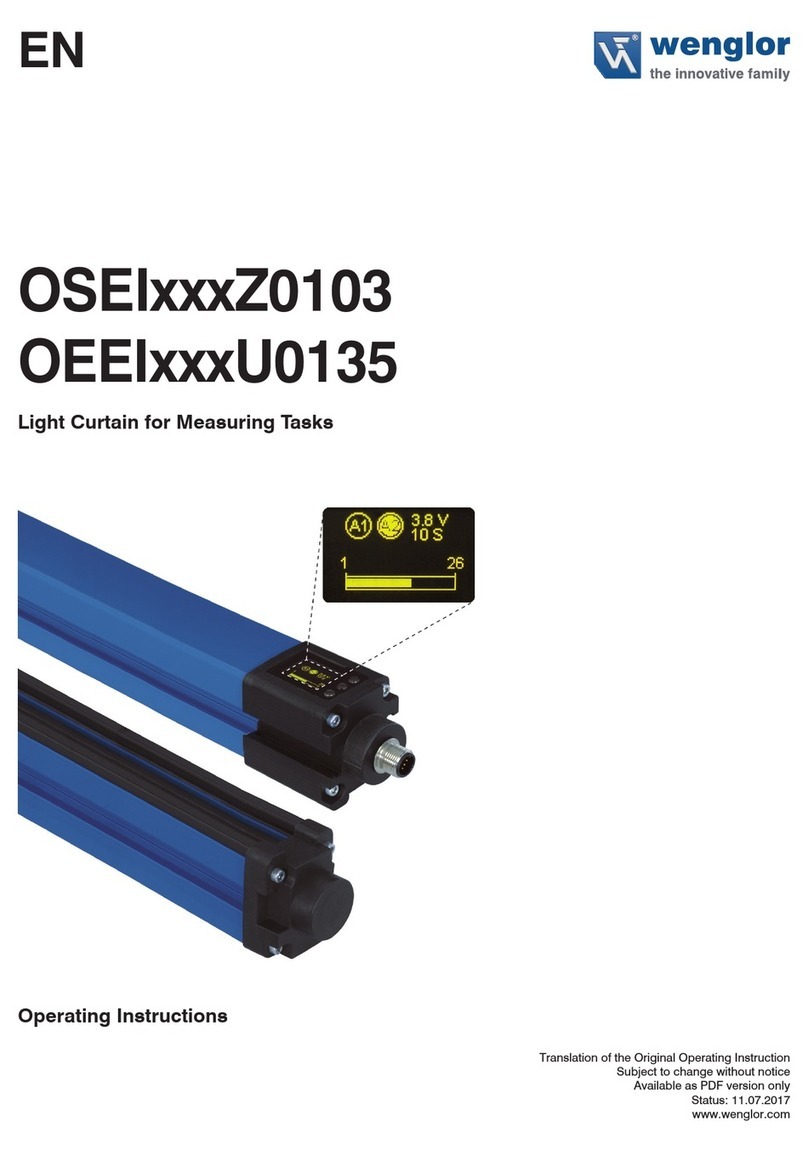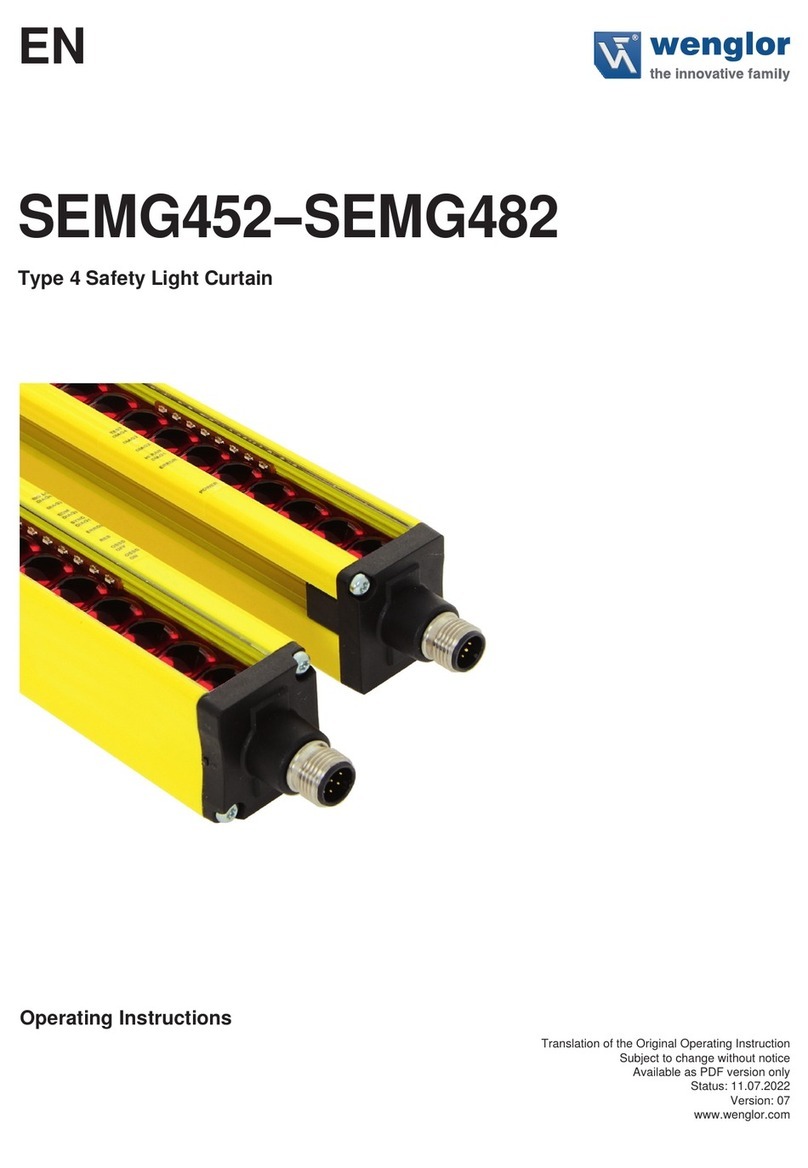
Sensor
Object
Switching Reserve
Hysteresis
Making point
Breaking point
Teach Distance
Capteur
Objet
Réserve de commutation
Hystérèse
Point d'enclenchement
Point de désactivation
Teach Distance
wenglor®
E
Fwenglor®
External Teach-In
The sensor is equipped with an additional input for external
teach-in (PIN 5). If a positive voltage (> 1 s) signal is
applied to this input, the sensing distance is automatically
set. The External Teach-In via PIN 5 is only possible if a
5-pin connection cable is used.
Attention!
The sensing distance can be set by pressing the teach-
in key. However, if a sharp object is used to this end, for
example a needle or tweezers, damage to the rubber
membrane which covers the key may result. A
maximum pressing force of 0 N may not be exceeded.
Switching Range
All sensing range data refer to white KODAK paper, matt,
00g/m , with a surface area of 40×40 cm and with light
striking vertically at 90° and 5 °C. Changes to the sensing
range caused by different angles of reflection are shown in
the Sensing Range Diagram.
Mo nting instr ctions
During operation of the sensors, the corresponding electrical
and mechanical regulations, as well as safety regulations
must be observed. The sensor must be protected from
mechanical impact.
Adj sting instr ctions
Object Teach-In
By pressing the Teach-In key at the sensor
the switching distance to the object is
teached-in.
Mount the sensor according to the
mounting instructions
Adjust the light spot to the object.
Press Teach-In key until the LED "Switching
Status Indicator" blinks (approx. 1 sec.)
then release.
à Switching Distance to object is set.
Check the switching function.
If you teach without an object or the object is located too far
away from the sensor,
the switching distance is set to the end of the Working Range.
("Switching Status Indicator" blinks fast).
If the object is located too close to the sensor, the switching
distance is set to the beginning of the Working Range.
General Technical Data
Working Range 04000 mm
Adjustable Range 504000 mm
Supply Voltage 1030 V DC
Current Consumption £ 70 mA
Voltage Drop < ,5 V
max. Switching Current PNP 00 mA
Hysteresis < 5 mm
Switching Reserve < 5 mm
Temperature Drift < %
Short Circuit Protection yes
Overload Protection yes
Reverse Polarity Protection yes
Temperature Range 5° C+60° C
Switching Frequency 1000 Hz
Response Time 0,5 ms
Light Source Laser (red)
Laser Class
Protection IP 68
Apprentissage externe
Le détecteur dispose dune entrée supplémentaire pour
lapprentissage externe (PIN 5). La présence dun front
positif sur lentrée (> 1 s) déclenche automatiquement
le réglage de la portée à la valeur appropriée. Pour un
apprentissage externe au PIN 5, il est nécessaire d'utiliser
un câble de raccordement 5-pôles.
Attention!
La portée du détecteur peut être réglée en appuyant la
touche apprentissage. Eviter lutilisation dobjets pointus
pour cette manipulation. La membrane en caoutchouc
peut s'abîmer. La pression maximum sur la touche ne
doit pas excéder 0 N.
Distance de détection
Les distances de détection se réfèrent au papier
KODAK blanc-mat de 00g/m , d'une surface de 40×40
cm et d'un rayon lumineux perpendiculaire à la surface
du papier et à 5°C. Les variations de distance de
commutation en fonction de la rémission sont indiquées
dans la courbe "Distance de détection".
Instr ctions de montage
Lors de la mise en service des détecteurs, respecter
les prescriptions de sécurité, normes et instructions
électriques et mécaniques appropriées. Protéger le
détecteur contre toute influence mécanique pouvant le
dérégler ou endommager.
Instr ctions de montage :
Apprentissage s r objet
L'apprentissage de la distance de détection
sur l'objet se réalise en appuyant sur le
bouton Teach du capteur.
Installer le capteur suivant les instructions
de montage
Diriger le spot lumineux sur l'objet
Appuyer sur le bouton Teach jusqu'à ce
que la LED indiquant l'état de commutation
clignote (environ 1 s), puis relacher.
à La distance de commutation à l'objet
a été réglée.
Vérifier la commutation
Si un apprentissage est réalisé sans objet, par exemple un
objet trop éloigné, alors la distance de commutation sera la
distance maximale de travail du capteur (la LED de
commutation clignote rapidement).
Si un apprentissage est réalisé sur un objet trop proche,
alors la distance de commutation sera la distance minimale
de travail du capteur.
Caractéristiq es techniq es
Plage de travail 04000 mm
Plage ajustable 504000 mm
Tension d'alimentation 1030 V DC
Consommation £ 70 mA
Chute de tension < ,5 V
Courant commuté max. PNP 00 mA
Hystérèsis < 5 mm
Réserve de commutation < 5 mm
Dérive en température < %
Protection contre les court-circuit oui
Protection contre les surcharges oui
Protection contre les inversions de polarité oui
Température d'utilisation 5 °C+60 °C
Fréquence de commutation 1000 Hz
Temps de réponse 0,5 ms
Type de lumière Laser (rouge)
Classe laser
Degré de protection IP 68
68 = Signalisation de la tension d'alimentation
01 = Signalisation de l'état de commutation
06 = Touche apprentissage
Pannea
Suiting Connection Technology No.
Suiting Mounting Technology No.
Complimentary Prod cts (see catalog)
2 35
340
Référence connectique
appropriée
No. de Technique de
montage appropriée
Prod its complémentaires (voir catalog e)
2 35
340
Proper Use
This wenglor product has to be used according to the
following functional principle:
Transit Time Sensors
The transmitter and the receiver are integrated into a single
housing.
The sensors measure the distance between the sensor and
the object. If the object reaches the adjusted Switching Point,
the Output switches.
They function in accordance with the principle of transit time
measurement. For this reason, the object's color, shape and
surface characteristics have practically no influence on the
switching point. Even dark objects can be reliably recognized
against bright backgrounds.
A large working range is achieved by these sensors.
The sensors work directly onto an object.
Safety Preca tions
This operating instruction is part of the product and must
be kept during its entire service life.
Read this operating instruction carefully before using the
product.
This product is not suitable for safety applications.
Installation, start-up and maintenance of this product
should only be carried out by trained personal.
Tampering with or modifying the product is not permissible.
Protect the product against contamination during start-up.
Class Laser 2 (EN 60825-1)
Observe all applicable standards
and safety precautions.
The enclosed laser warning
labels must be attached and
visible at all time. Do not stare
into beam.
Long e r d'onde
Ce produit wenglor doit être utilisé selon le mode de
fonctionnement suivant:
Capte r Temps transit
Emetteur et récepteur sont placés dans un seul et même boîtier.
Les détecteurs déterminent la distance entre le détecteur et l'objet.
Si l'objet atteint la portée réglée, la sortie commute.
Ils travaillent sur le principe de mesure du temps de transit de la
lumière. C'est pourquoi la couleur, la forme et l'état de surface des
objets n'ont pratiquement aucune influence sur le point de
commutation. Même les objets foncés devant un arrière-plan clair
peuvent être détectés de façon sûre.
Ces détecteurs ont une grande plage de mesure.
Ils travaillent en réflexion directe sur l'objet.
Conseils de séc rité
Ces instructions de Service sont une partie intégrante du produit
et doivent être conserves durant toute la durée de vie du produit.
Lire les Instructions de Service avant la mise en marche.
Le produit nest adéquat pour des applications de sécurité.
Installation, raccordement et réglage ne doivent être effectués
que par du personnel qualifié.
Toute intervention ou modification sur le produit ne sont pas
autorisées.
Lors de la mise en service, protéger lappareil des saletés.
Appareil à laser de classe 2
(EN 60825-1)
Respecter les normes et prescriptions
de sécurité.
Observer les instructions annexées.
Ne pas regarder dans le faisceau.
beam.
68 = Supply Voltage Indicator
01 = Switching Status Indicator
06 = Teach Button
Ctr. Panel
68 01 06
TA2
68 01 06
TA2























